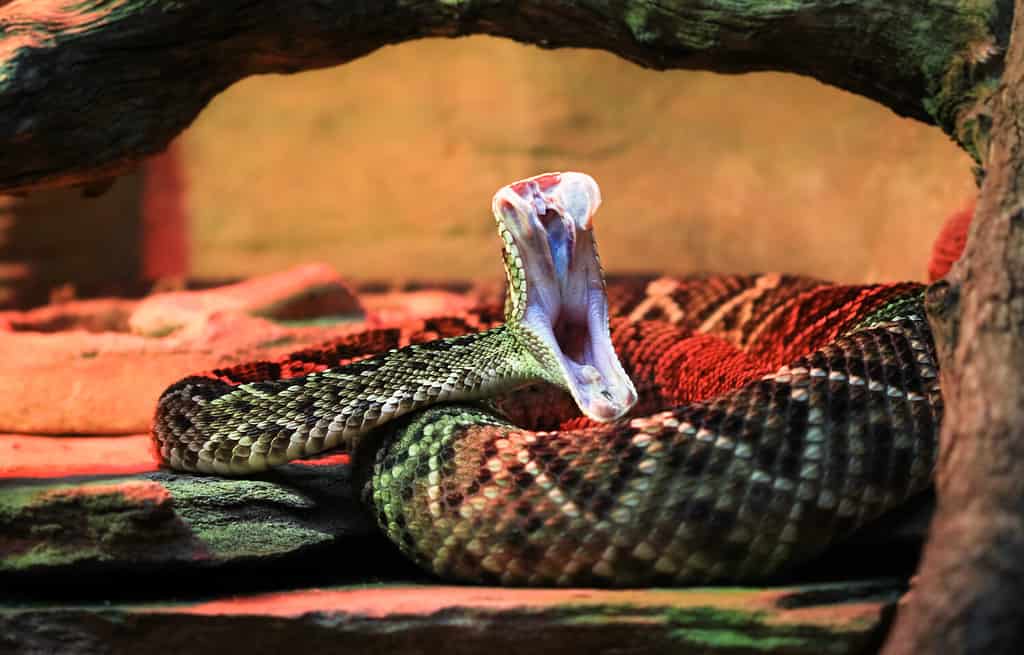Rattlesnakes are venomous snakes that belong to the family Viperidae. These snakes are easily recognized for the rattle at the end of their tails. Many people fear this snake because of its venomous bite. With a bite force of 150 PSI and venomous fangs, it is no wonder many people avoid this snake. Although many people fear this snake, few know much about its venomous fangs. How many do they have? Can they replace them? How do rattlesnakes lose fangs? This article aims to answer all those questions and more as we dive into all the details surrounding rattlesnake fangs.
How Do Rattlesnakes Lose Their Fangs?

Rattlesnakes have heat-sensing pits near the tip of their nose to help them locate potential prey.
©Kevin Wells Photography/Shutterstock.com
Rattlesnakes are venomous predators that like to catch and eat live prey. They feast on various small mammals, including rats, mice, rabbits, and lizards. Finding prey is no problem because of their many adaptations, such as their heat-sensing pits near the tip of their nose and their ability to sense vibrations of nearby prey. Although these predators find their prey easily, they sometimes struggle once they’ve captured it.
Once a snake captures its prey, they use their large fangs to inject their venom into their prey. The venom works quickly to subdue the prey, but during the struggle of the capture between the rattlesnake and its prey, it is common for the snake’s fangs to be wiggled loose and fall out. If the tooth does not fall out during the struggle but is made loose, the snake will most likely swallow the fang, and it will pass through the rattlesnake’s digestive system with their last meal.
Rattlesnake Teeth: The Basics and How Often They Lose Them
Although the fangs are perhaps the most terrifying thing in this snake’s mouth, they are not the only thing. Rattlesnakes have solenoglyphous dentition, meaning they have teeth coupled with their fangs. While people generally refer to all snake teeth as fangs, not all of those teeth are venomous, fear-inducing fangs. The rattlesnake’s teeth are pulp, dentin, cementum, and enamel.
The rattlesnake can hinge its venomous fangs when they are not needed and extend them outside of their mouth when they are ready to attack. A rattlesnake’s teeth are polyphyodont, meaning they lose and regrow their teeth often. A rattlesnake will shed its fangs every six to ten weeks.
Rattlesnake Fangs: Common Questions

Usually, rattlesnakes will only attack if and when humans provoke or threaten them.
©Chase D’animulls/Shutterstock.com
What Happens If a Rattlesnake Loses Its Fangs?
When a rattlesnake loses its fangs, it either drops them from its mouth and leaves them behind, or swallows them. The snake will regrow and replace its fangs every six to ten weeks.
How Do Rattlesnakes Use Their Venom?
When a snake is not actively using its fangs, it keeps the fangs lying parallel to its jaw. When needed, muscular contractions in the snake’s mouth allow the fang to rotate so they extend outside of the mouth. Each fang is hollow and connects to a venom gland. Ducts deliver venom to the fangs, and the snake injects it into the prey it is biting.
What Is the Survival Rate of a Rattlesnake Bite?
According to the US Forest Service, “rattlesnake bites are rarely fatal with less than 1 in 600 resulting in death, and approximately 33 percent not containing injection of venom at all.” Rattlesnakes are generally not aggressive, so unless provoked or threatened, they should avoid contact with humans.
What Do Rattlesnakes Eat?
Rattlesnakes eat small mammals like rats, mice, rabbits, and birds.
Rattlesnake Fang Facts!
- The eastern diamondback rattlesnake has the second longest fangs in the world.
- Venom from a rattlesnake contains toxins that can harm red blood cells and stop blood clotting.
- Rattlesnake fangs are hollow.
- The rattlesnake’s fangs are like moveable hypodermic syringes.
- According to the Desert Museum, “approximately 20 percent of defensive strikes are dry,” meaning no venom is injected.
The photo featured at the top of this post is © Clement Horvath/Shutterstock.com
Discover the "Monster" Snake 5X Bigger than an Anaconda
Every day A-Z Animals sends out some of the most incredible facts in the world from our free newsletter. Want to discover the 10 most beautiful snakes in the world, a "snake island" where you're never more than 3 feet from danger, or a "monster" snake 5X larger than an anaconda? Then sign up right now and you'll start receiving our daily newsletter absolutely free.
Thank you for reading! Have some feedback for us? Contact the AZ Animals editorial team.







